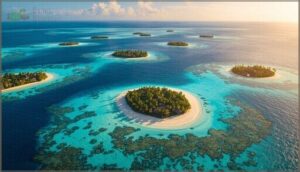This site is supported by our readers. We may earn a commission, at no cost to you, if you purchase through links.
You won’t find snakes slithering across every corner of the planet. Several places around the world remain completely snake-free, offering a unique refuge for those who’d rather not encounter these reptiles.
Antarctica stands as the most obvious example, where brutal cold makes survival impossible for any snake species. But you’ll also discover entire island nations like New Zealand, Ireland, and Iceland where snakes have never established populations. Geographic isolation, freezing temperatures, and vast ocean barriers have kept these regions naturally protected.
Cold-climate areas in Greenland, northern Alaska, and parts of the Arctic Circle also lack snake populations due to environmental conditions that fall well below the survival threshold for these cold-blooded animals. Understanding what keeps these areas snake-free reveals fascinating insights about natural barriers, climate limits, and the ongoing efforts to protect these unique ecosystems from potential invasive species.
Table Of Contents
- Key Takeaways
- The Only Continent Without Snakes: Antarctica
- Snake-Free Island Nations Around The World
- Cold Climate Regions Without Snake Populations
- Why These Places Remain Snake-Free
- Protecting Snake-Free Regions From Invasive Species
- Frequently Asked Questions (FAQs)
- Are there snakes in tropical islands?
- Are there any places where snakes have been introduced due to human activities?
- What is the impact of climate change on snake presence?
- What are some of the consequences of introducing snakes to new areas?
- How can people prevent snakes from entering their areas?
- Can snakes survive in high altitude mountain regions?
- Are there venomous reptiles in snake-free areas?
- How do snake-free islands handle accidental introductions?
- What replaced snakes in these isolated ecosystems?
- Could climate change allow snakes to colonize?
- Conclusion
Key Takeaways
- Antarctica stands as the only continent completely free of snakes because extreme cold prevents their survival, while island nations like New Zealand, Ireland, and Iceland remain snake-free due to geographic isolation and ocean barriers that prevented post-glacial colonization.
- Cold-blooded snakes can’t survive in regions where temperatures consistently drop below 5–10°C, which explains why Arctic areas in Greenland, northern Alaska, and Scandinavia’s high-elevation zones naturally exclude snake populations.
- These snake-free zones face serious threats from accidental introductions through cargo and the pet trade, as demonstrated by Guam’s catastrophic loss of 22 out of 25 bird species after brown tree snakes arrived via military shipments.
- Protecting snake-free regions requires aggressive biosecurity measures including strict border controls, detector dogs at entry points, and rapid-response teams, with Hawaii imposing fines up to $200,000 and potential imprisonment for illegal snake possession.
The Only Continent Without Snakes: Antarctica
Antarctica stands alone as the only continent on Earth where you won’t find a single snake. The extreme conditions there make it impossible for these cold-blooded reptiles to survive.
Let’s look at the key reasons why snakes can’t call this frozen continent home.
Extreme Cold Prevents Snake Survival
Antarctica’s extreme coldness creates conditions where snakes simply can’t function. Unlike warm-blooded animals, snakes rely on external heat to power their bodies, and when temperatures drop below their thermal limits, survival becomes impossible.
Here’s why the Antarctic climate shuts snakes out completely:
- Brumation strategies fail: Snakes need unfrozen refuges to hibernate, but Antarctica’s permafrost offers nowhere to escape lethal cold
- Metabolic rates collapse: Below 10°C, most snakes can’t move, hunt, or digest food effectively
- Climate modeling confirms: Antarctic projections show temperatures staying far below snake activity thresholds through this century
- No warm seasons exist: Even summer temperatures hover near freezing, eliminating the basking opportunities snakes need in other snake-free zones
Snakes in colder climates rely on reptilian hibernation to survive freezing temperatures.
Lack of Suitable Prey and Habitat
Even if the cold didn’t stop snakes, Antarctica’s ecosystem wouldn’t support them. The continent’s ice-free areas—only 0.4% of the landmass—host sparse invertebrate communities like mites and springtails, but no rodents, amphibians, or small reptile communities that snakes generally hunt.
Bird and seal colonies concentrate along coasts seasonally, creating patchy prey availability unsuitable for ambush predators. Island prey scarcity, microclimate limitations, and minimal habitat complexity make snake-free zones inevitable here. Antarctica is the only continent that’s completely snake-free.
Permanently Frozen Landscape
Beyond prey shortages, you’re looking at a continent locked in permanent ice. The Antarctic ice sheet covers 98% of the land surface—around 14 million square kilometers—with Antarctic permafrost and ground ice extending several meters deep.
Mean annual temperature regimes hover between −20 and −55 degrees Celsius inland, far below biological constraints for any reptile. Sea ice nearly doubles the frozen domain each winter, reinforcing cold climate impact across snake-free zones.
Snake-Free Island Nations Around The World
You might be surprised to learn that several island nations around the world don’t have a single snake slithering through their forests or fields. These places share common traits like geographical isolation, cold climates, or strict conservation laws that keep snakes out.
Let’s look at some of the most notable snake-free islands and what makes them unique.
New Zealand’s Complete Absence of Snakes
New Zealand stands apart as one of the planet’s truly snake-free zones, protected by both nature and law. Geographic isolation and strict Biosecurity Measures keep this island ecosystem safe from serpents. Here’s why you won’t encounter any snakes here:
- Legal Prohibition under the Hazardous Substances and New Organisms Act makes ownership or import illegal
- Interception Responses catch one to two snakes yearly at borders, preventing establishment
- Native Vulnerability means ground-nesting birds lack defenses against potential snake predators
This Ecological Rationale preserves unique wildlife.
Ireland’s Snake-Free History and Geography
Ireland remains one of the world’s most famous snake-free zones, though the St. Patrick Myth misleads many visitors. Post-glacial Colonization never brought snakes here—the island separated from Britain roughly 8,500 years ago, before serpents could migrate.
Climate Constraints and Geographic Isolation created natural barriers. Today, Biosecurity Measures prevent Modern Introductions, protecting this unique ecosystem where Saint Patrick’s legend overshadows simple geology.
Iceland’s Harsh Climate Barrier
Iceland sits among the world’s most secure snake-free zones, and you won’t find serpents anywhere on this North Atlantic island. Winter temperatures hitting −39.7 °C and an Arctic climate that limits reptile survival create absolute dispersal barriers.
Geographic barriers—over 970 km from mainland Europe—prevent colonization, while legal restrictions block imports. Public perception correctly identifies Iceland as completely snake-free.
Cape Verde’s Unique Island Ecosystem
Off Africa’s western coast, Cape Verde stands as a true snake-free zone with 19 terrestrial reptile species—all lizards, geckos, and skinks. Geographic isolation shaped unique ecosystems where endemic reptiles thrive without serpent predators. However, invasive species threaten this balance:
- Exotic geckos now compete with 12 endemic lizard taxa
- Roughly 78% of endemic plants face threatened status
- Introduced Agama lizards disrupt native reptile populations
- Conservation actions monitor highly localized species
- Plant biodiversity suffers from habitat degradation and exotic arrivals
Island ecosystems remain vulnerable without natural defenses against non-native invaders.
Small Pacific Islands (Tuvalu, Nauru, Kiribati)
Scattered across the central Pacific, tiny island nations face a paradox: no native land snakes yet ongoing conservation challenges from invasive species. These geographical areas remain mostly snake-free due to extreme isolation and limited habitats, though island biosecurity remains critical.
| Island Nation | Land Snake Status | Marine Snakes Present |
|---|---|---|
| Tuvalu | No confirmed terrestrial species | Sea snakes in surrounding waters |
| Nauru | One introduced species (Brahminy blindsnake) | Yellow-bellied sea snake offshore |
| Kiribati | No native land snakes | Banded sea snakes breed on western atolls |
| Geographic Factor | Low-lying coral atolls limit habitat diversity | Thousands of kilometers from continental sources |
| Invasion Risk | Cryptic species arrive via cargo and soil transport | Island ecosystems vulnerable without natural defenses |
Island biosecurity and surveillance programs help Pacific islands protect fragile ecosystems from introduced species that threaten unique native wildlife.
Cold Climate Regions Without Snake Populations
When you think about snake-free places, frozen landscapes probably come to mind first. Cold-blooded reptiles simply can’t survive where temperatures stay below freezing for most of the year.
Let’s look at three major cold climate regions where you won’t find any snakes.
Greenland’s Arctic Environment
Greenland sits firmly in the Arctic Circle, where ice sheet dynamics and brutal Arctic climate factors make snake survival impossible. You’ll find this massive island wrapped in extreme cold, with most of the land buried under permanent ice.
Consider these conditions:
- Annual temperatures average well below freezing across interior regions
- Seasonal sea ice surrounds coastal areas for much of the year
- Terrestrial ecosystems support only cold-adapted mammals like musk oxen and Arctic foxes
These snake-free zones remain among Earth’s harshest cold climates.
Northern Alaska’s Frozen Terrain
Northern Alaska’s Arctic Coastal Plain lies well above 68° N latitude, placing you beyond the natural range of all reptiles in North America. Permafrost impact dominates this landscape, with frozen ground extending hundreds of meters deep and winter temperatures plunging below −40 °C.
These climate barriers, combined with prey scarcity in tundra ecosystems and dispersal obstacles like the Brooks Range, make Alaska’s snake-free zones remain permanently inhospitable to cold-blooded reptiles.
Arctic Circle Areas in Scandinavia
Unlike Alaska, Scandinavia’s Arctic Circle isn’t entirely snake-free. The European adder reaches parts of Norway and Sweden above 66.5° N, making it the world’s most northern snake.
However, climate constraints and habitat limitations create extensive snake-free sectors across high-elevation tundra, windswept coastal islands, and Finnish Lapland’s open bogs, where even this cold-adapted species can’t survive the prolonged winters and scarce basking sites.
Why These Places Remain Snake-Free
Understanding why snakes don’t live in certain places comes down to a few key factors that act as natural barriers. These regions share specific traits that make it nearly impossible for snakes to establish populations, no matter how adaptable they might be.
Let’s look at what keeps these areas snake-free and how nature itself creates these protective boundaries.
Geographic Isolation as a Natural Barrier
When oceans span hundreds or thousands of kilometers, you face natural snake-free zones shaped by geographic isolation. Island biogeography shows that dispersal limitations prevent most snakes from crossing vast water barriers—New Zealand sits over 1,600 kilometers from Australia, while Ireland became isolated around 6,500 BCE.
These geographic factors influencing snake distribution create colonization resistance, protecting island ecosystems and snakes from ever establishing populations in snake-free regions.
Temperature Thresholds for Snake Survival
Beyond water barriers, cold itself keeps snakes out. As cold-blooded animals, snakes can’t regulate body temperature internally—they rely entirely on climate to drive survival. Research shows Critical Thermal Minimums around 5–10 °C halt movement, while Preferred Body Temperature hovers near 28–32 °C for peak performance. Even during Brumation Survival in temperate zones, dens must stay above freezing. Marine Snake Thermals follow similar rules, limiting species to warm seas. Climate Change Impact may shift these boundaries, but for now, temperature regulation determines where snakes can—and can’t—live.
Five temperature thresholds that define snake habitats and survival conditions:
- Critical survival floor: Most species lose motor function below 5–10 °C, blocking colonization of consistently cold regions.
- Preferred activity range: Active snakes maintain body temperatures between 25–32 °C, driving habitat selection toward warm microclimates.
- Winter den requirements: Overwintering sites must remain above 0 °C to prevent lethal freezing during brumation periods.
- Marine thermal limits: Sea snakes function best at 28–30 °C, confining them to tropical and subtropical waters year-round.
- Upper tolerance ceilings: Extreme heat above roughly 40 °C reduces performance and survival, shaping the impact of climate on snakes globally.
Ocean Barriers Preventing Snake Migration
Even if you find warm islands thousands of miles offshore, sea snakes can’t reach them. Ocean currents sweep these swimmers away from snake-free zones, while thermal tolerance demands surface temps above 18 °C year-round—conditions absent along crossing routes.
Salinity dependence compounds the challenge: despite being marine, sea snakes must drink freshwater, limiting dispersal capacity across open ocean.
Habitat depth and genetic isolation keep populations landlocked, protecting island ecosystems and snakes alike through geographical isolation that defines sea snake distribution worldwide.
Lack of Land Bridges and Migration Routes
When continental drift tore apart ancient landmasses, snakes missed their window. New Zealand separated from Gondwana 85 million years ago—before snakes could cross—while rising sea levels drowned Europe’s land bridges 8,500 years ago, stranding Ireland as a snake-free zone.
These dispersal constraints mean geographical isolation, not just climate, keeps snake-free regions secure. Without animal migration routes, long-term isolation becomes permanent protection for these unique ecosystems.
Protecting Snake-Free Regions From Invasive Species
Keeping these regions snake-free isn’t just about geography—it requires active protection. Some places have learned the hard way that one accidental introduction can wreck an entire ecosystem.
Here’s how snake-free regions guard their borders and protect what makes them unique.
Hawaii’s Strict Anti-Snake Laws
Hawaii takes protecting its snake-free zones seriously. You won’t find snakes here naturally, and the state wants to keep it that way through some of the toughest conservation laws anywhere.
Legal Penalties and Transport Controls:
- Criminal charges — Possession can result in class C felony charges, with fines ranging from $50,000 to $200,000 and potential imprisonment of three to five years.
- Port inspections — Agricultural checkpoints at airports screen all incoming passengers, baggage, and cargo for unauthorized animals.
- Amnesty Program — You can surrender illegal animals without prosecution if you turn them in voluntarily before an investigation starts.
- Risk Framing and Incident Response — The brown tree snake threat from Guam drives prevention efforts, with rapid same-day response teams capturing any reported snakes to protect Hawaii’s snake-free regions.
New Zealand’s Border Control Measures
Like a fortress protecting snake-free zones, New Zealand enforces the Biosecurity Act with layered border surveillance that catches roughly 74 exotic reptile and amphibian interceptions yearly. You’ll encounter x-ray screening, detector dogs, and cargo inspections at every entry point.
From 1989 to 2013, authorities logged 112 snake interception records—each one stopped cold. Smuggling deterrence works through public awareness campaigns and strict conservation laws that keep these snake-free regions secure.
Conservation of Unique Native Ecosystems
When invasive snakes breach snake-free zones, native fauna face extinction—Guam lost 22 of 25 bird species to brown tree snakes, collapsing forest regeneration.
When invasive snakes breach protected regions, native species face extinction—Guam lost 22 of 25 bird species to brown tree snakes
Protecting unique ecosystems demands strict biosecurity measures at ports, community surveillance networks, and rapid-response protocols.
Island ecosystems depend on this ecological balance; prevention costs far less than restoration ecology after invasion.
Your support for conservation of unique ecosystems safeguards irreplaceable biodiversity that can’t recover once lost.
Frequently Asked Questions (FAQs)
Are there snakes in tropical islands?
Most tropical islands do host snakes, with Indonesia and the Philippines ranking among global hotspots for snake diversity. However, some Pacific islands like Tuvalu and Kiribati remain completely snake-free zones.
Are there any places where snakes have been introduced due to human activities?
Cargo pathways and the pet trade have created catastrophic human-mediated introductions worldwide. Brown tree snakes devastated Guam’s ecosystem after arriving via military shipments, triggering urgent biosecurity responses to protect vulnerable island ecosystems from invasive species.
What is the impact of climate change on snake presence?
Climate change drives range shifts, altering snake distribution and habitats. Global warming extends activity patterns, increases snakebite risk in temperate zones, and reshapes diversity hotspots.
Extreme events like droughts and heatwaves complicate the impact of climate on snake survival.
What are some of the consequences of introducing snakes to new areas?
While snakes control rodent populations in their native ranges, introduction of nonnative species causes severe biodiversity loss, ecosystem disruption, economic impacts, human health risks, and biosecurity burdens—consequences that demand rigorous biosecurity to prevent ecological disaster.
How can people prevent snakes from entering their areas?
You can prevent snakes by sealing entry points, managing prey through rodent control, modifying habitat by removing debris, and maintaining biosecurity measures.
Personal safety practices and human intervention help protect snake-free environments from ecological consequences of nonnative species introduction.
Can snakes survive in high altitude mountain regions?
Your boots crunch on rocky ground, the thinning air cold in your lungs. Snakes can survive here—some vipers reach 16,000 feet in the Himalayas—but extreme altitude limits coldblooded reptiles.
Temperature constraints and environmental factors create increasingly snake-free zones above the tree line, though climate change may shift these boundaries.
Are there venomous reptiles in snake-free areas?
Most snakefree zones lack venomous reptiles entirely, but sea snake incursions occur in New Zealand’s waters.
Venomous invertebrates like spiders pose greater risks in these snakefree environments, where climate limitations and biosecurity measures prevent invasive species establishment.
How do snake-free islands handle accidental introductions?
Hawaii intercepted ten brown tree snakes using detector dogs at airports.
Snake-free islands employ biosecurity measures, rapid response teams, public awareness campaigns, legal penalties up to $200,000, and eradication protocols to prevent ecological consequences of snake introduction.
What replaced snakes in these isolated ecosystems?
In snake-free regions, avian predators like raptors and seabirds dominate vertebrate hunting, while mammalian niches fill with foxes and rodents.
Invertebrate dominance and microbial decomposers handle energy transfer where reptiles never existed.
Could climate change allow snakes to colonize?
Climate change could shake things up. Warming facilitates range expansion risks as snakes track shifting habitats into formerly cold regions, raising island colonization threats.
Yet colonization limits—like ocean barriers and biosecurity—still constrain human-snake conflict zones.
Conclusion
Think of these snake-free zones as nature’s own sanctuary—carved by ice, protected by ocean, and maintained by vigilance. Whether you’re drawn to Antarctica’s frozen expanse or New Zealand’s isolated shores, these places where there are no snakes offer more than just reptile-free landscapes.
They demonstrate how powerful geographic barriers remain, and why protecting these unique ecosystems from invasive species isn’t just cautious policy—it’s essential preservation of something increasingly rare.
- https://timesofindia.indiatimes.com/etimes/trending/discover-the-regions-on-earth-where-snakes-are-not-found/articleshow/117192123.cms
- https://a-z-animals.com/articles/islands-that-have-no-snakes/
- https://thisbugslife.com/2021/05/13/which-places-in-the-world-have-no-snakes/
- https://www.popsci.com/places-with-no-snakes/
- https://www.nature.com/articles/s41598-019-44732-z
















